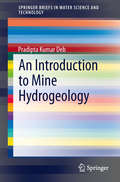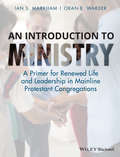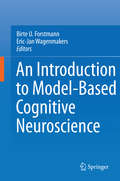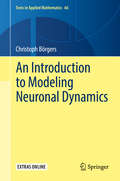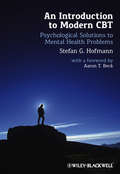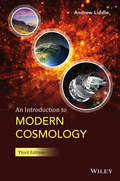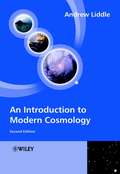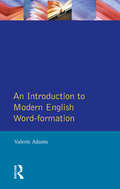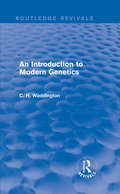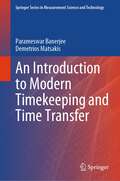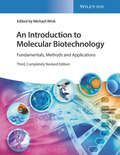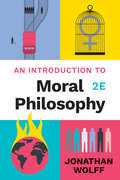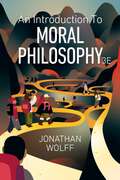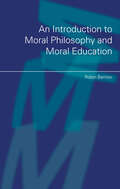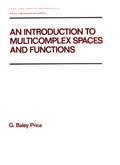- Table View
- List View
An Introduction to Mine Hydrogeology (SpringerBriefs in Water Science and Technology)
by Pradipta Kumar DebAn Introduction to Mine Hydrogeology briefly describes the subject of hydrogeology so that this knowledge can be integrated into mine development planning. It emphasizes not only the hydrochemical but also the physical impacts of the hydrogeological environment on the mine and its surroundings. Further, it discusses the methodologies used in mine hydrogeological studies, showcased by selected studies on Indian mines.
An Introduction to Ministry: A Primer for Renewed Life and Leadership in Mainline Protestant Congregations
by Ian S. Markham Oran E. WarderAn Introduction to Ministry is a comprehensive and ecumenical introduction to the craft of ministry for ministers, pastors, and priests that make up the mainline denominations in the United States. Ecumenically-focused, It offers a grounded account of ministry, covering areas such as vocation, congregational leadership, and cultivation of skills for an effective ministry. Covers the key components of the M.Div. curriculum, offering a map and guide to the central skills and issues in training Explores the areas of vocation, skills for ministry, and issues around congregational leadership Each topic ends with an annotated bibliography providing an indispensable gateway to further study Helps students understand both the distinctive approach of their denomination and the relationship of that approach to other mainline denominations Advocates and defends a generous understanding of the Christian tradition in its openness and commitment to broad conversation
An Introduction to Model-Based Cognitive Neuroscience
by Eric-Jan Wagenmakers Birte U. ForstmannTwo recent innovations, the emergence of formal cognitive models and the addition of cognitive neuroscience data to the traditional behavioral data, have resulted in the birth of a new, interdisciplinary field of study: model-based cognitive neuroscience. Despite the increasing scientific interest in model-based cognitive neuroscience, few active researchers and even fewer students have a good knowledge of the two constituent disciplines. The main goal of this edited collection is to promote the integration of cognitive modeling and cognitive neuroscience. Experts in the field will provide tutorial-style chapters that explain particular techniques and highlight their usefulness through concrete examples and numerous case studies. The book will also include a thorough list of references pointing the reader towards additional literature and online resources.
An Introduction to Model-Based Cognitive Neuroscience
by Birte U. Forstmann Brandon M. TurnerThe main goal of this edited collection is to promote the integration of cognitive modeling and cognitive neuroscience. Experts in the field provide tutorial-style chapters that explain particular techniques and highlight their usefulness through concrete examples and numerous case studies. The book also includes a thorough list of references pointing the reader toward additional literature and online resources. The second edition of Introduction to Model-Based Cognitive Neuroscience explores important new advances in the field including joint modeling and applications in areas such as computational psychiatry, neurodegenerative diseases, and social decision-making.
An Introduction to Modeling Neuronal Dynamics
by Christoph BörgersThis book is intended as a text for a one-semester course on Mathematical and Computational Neuroscience for upper-level undergraduate and beginning graduate students of mathematics, the natural sciences, engineering, or computer science. An undergraduate introduction to differential equations is more than enough mathematical background. Only a slim, high school-level background in physics is assumed, and none in biology. Topics include models of individual nerve cells and their dynamics, models of networks of neurons coupled by synapses and gap junctions, origins and functions of population rhythms in neuronal networks, and models of synaptic plasticity.An extensive online collection of Matlab programs generating the figures accompanies the book.
An Introduction to Modelling of Power System Components (SpringerBriefs in Electrical and Computer Engineering)
by S KrishnaThe brief provides a quick introduction to the dynamic modelling of power system components. It gives a rigorous derivation of the model of different components of the power system such as synchronous generator, transformer, transmission line, FACTS, DC transmission system, excitation system and speed governor. Models of load and prime movers are also discussed. The brief can be used as a reference for researchers working in the areas of power system dynamics, stability analysis and design of stability controllers. It can also serve as a text for a short course on power system modelling, or as a supplement for a senior undergraduate/graduate course on power system stability.
An Introduction to Modern Analysis
by Vicente Montesinos Václav Zizler Peter ZizlerExamining the basic principles in real analysis and their applications, this text provides a self-contained resource for graduate and advanced undergraduate courses. It contains independent chapters aimed at various fields of application, enhanced by highly advanced graphics and results explained and supplemented with practical and theoretical exercises. The presentation of the book is meant to provide natural connections to classical fields of applications such as Fourier analysis or statistics. However, the book also covers modern areas of research, including new and seminal results in the area of functional analysis.
An Introduction to Modern CBT
by Stefan G. HofmannAn Introduction to Modern CBT provides an easily accessible introduction to modern theoretical cognitive behavioral therapy models. The text outlines the different techniques, their success in improving specific psychiatric disorders, and important new developments in the field.* Provides an easy-to-read introduction into modern Cognitive Behavioral Therapy approaches with specific case examples and hands-on treatment techniques* Discusses the theoretical models of CBT, outlines the different techniques that have been shown to be successful in improving specific psychiatric disorders, and describes important new developments in the field* Offers useful guidance for therapists in training and is an invaluable reference tool for experienced clinicians
An Introduction to Modern Cosmology
by Andrew LiddleA concise, accessible introduction to this exciting and dynamic subject.* Adopts an approach grounded in physics rather than mathematics.* Includes worked examples and student problems, along with hints for solving them and the numerical answers.* Many reviewers have commented that this is one of the best 'introductory undergraduate level' texts on the subject and they would all welcome a Second Edition.
An Introduction to Modern Cosmology
by Andrew LiddleAn Introduction to Modern Cosmology Third Edition is an accessible account of modern cosmological ideas. The Big Bang Cosmology is explored, looking at its observational successes in explaining the expansion of the Universe, the existence and properties of the cosmic microwave background, and the origin of light elements in the universe. Properties of the very early Universe are also covered, including the motivation for a rapid period of expansion known as cosmological inflation. The third edition brings this established undergraduate textbook up-to-date with the rapidly evolving observational situation. This fully revised edition of a bestseller takes an approach which is grounded in physics with a logical flow of chapters leading the reader from basic ideas of the expansion described by the Friedman equations to some of the more advanced ideas about the early universe. It also incorporates up-to-date results from the Planck mission, which imaged the anisotropies of the Cosmic Microwave Background radiation over the whole sky. The Advanced Topic sections present subjects with more detailed mathematical approaches to give greater depth to discussions. Student problems with hints for solving them and numerical answers are embedded in the chapters to facilitate the reader’s understanding and learning. Cosmology is now part of the core in many degree programs. This current, clear and concise introductory text is relevant to a wide range of astronomy programs worldwide and is essential reading for undergraduates and Masters students, as well as anyone starting research in cosmology.
An Introduction to Modern English Word-Formation
by Valerie AdamsA series to meet the need for books on modern English that are both up-to-date and authoritative.For the scholar, the teacher, the student and the general reader, but especially for English-speaking students of language and linguistics in institutions where English is the language of instruction, or advanced specialist students of English in universities where English is taught as a foreign language
An Introduction to Modern Genetics (Routledge Revivals: Selected Works of C. H. Waddington)
by C. H. WaddingtonFirst published in 1939 (second impression in 1950), this book provides an account of the changes in, and main principles of, genetics at that time. These are illustrated by references to the most authoritative and then recent investigations. Special attention is paid to the way in which genetics overlaps with other fields of inquiry, since it is often in these border-line subjects that the most important advances are to be expected. The book is particularly arranged to suit the convenience of students whose previous knowledge of genetics is small, and contains annotated bibliographies of suggestions for further reading.
An Introduction to Modern Japanese
by Richard Bowring Haruko Ury LaurieThis is the first book in a two-volume intensive one-year introductory course in Japanese, also suitable for those who wish to work at a slower pace. Students who finish this course will have a firm grasp of how the language works and enough knowledge of the writing system to tackle everyday written material with no more than a dictionary. Particular attention is paid to questions of grammar which foreign learners often find difficult, so Book One can also serve as a reference grammar. An Introduction to Modern Japanese uses both spoken and written forms from the outset. There are word lists for each lesson, and a comprehensive vocabulary for the whole course. Book One comprises fifty-two lessons which are accompanied by exercises and word lists in Book Two. The exercises ensure that the student has understood the grammar explained in the relevant lessons and give further practice in reading and recognising characters. Book Two also contains a full vocabulary, Japanese to English and English to Japanese.
An Introduction to Modern Japanese
by Richard Bowring Haruko Ury LaurieThis is the first book in a two-volume intensive one-year introductory course in Japanese, also suitable for those who wish to work at a slower pace. Students who finish this course will have a firm grasp of how the language works and enough knowledge of the writing system to tackle everyday written material with no more than a dictionary. Particular attention is paid to questions of grammar which foreign learners often find difficult, so Book One can also serve as a reference grammar. An Introduction to Modern Japanese uses both spoken and written forms from the outset. There are word lists for each lesson, and a comprehensive vocabulary for the whole course. Book One comprises fifty-two lessons which are accompanied by exercises and word lists in Book Two. The exercises ensure that the student has understood the grammar explained in the relevant lessons and give further practice in reading and recognising characters. Book Two also contains a full vocabulary, Japanese to English and English to Japanese.
An Introduction to Modern Timekeeping and Time Transfer (Springer Series in Measurement Science and Technology)
by Parameswar Banerjee Demetrios MatsakisThis book provides a comprehensive, systematic description of modern timekeeping and its specializations. Introductory chapters discuss the concept of time and its definition, then briefly look at pre-Atomic Era timekeeping to set the stage for the introduction of the atomic clock. Subsequent chapters focus on concepts such as frequency stability and measurement uncertainty, as well as computer network time-synchronization protocols including Network Time Protocol (NTP) and Precise Time Protocol (PTP). The book then delves into the nuts and bolts of the Global Navigation Satellite Systems (GNSS), Two-Way Satellite Time and Frequency Transfer, and Optical Time and Frequency Transfer. Timescale theory is then described as a way to combine clock data, and the algorithms and procedures used to generate Coordinated Universal Time (UTC) are given. Finally, there is a look at modern applications of timekeeping and time transfer.Featuring a glossary of all key terms, this book is highly recommended for trained or incoming physicists, engineers, or mathematicians working, for example, in manufacturing or timing laboratories. Additionally, it is suitable for use in introductory university courses dealing with the subject of timekeeping.
An Introduction to Molecular Anthropology
by Mark StonekingMolecular anthropology uses molecular genetic methods to address questions and issues of anthropological interest. More specifically, molecular anthropology is concerned with genetic evidence concerning human origins, migrations, and population relationships, including related topics such as the role of recent natural selection in human population differentiation, or the impact of particular social systems on patterns of human genetic variation. Organized into three major sections, An Introduction to Molecular Anthropology first covers the basics of genetics - what genes are, what they do, and how they do it - as well as how genes behave in populations and how evolution influences them. The following section provides an overview of the different kinds of genetic variation in humans, and how this variation is analyzed and used to make evolutionary inferences. The third section concludes with a presentation of the current state of genetic evidence for human origins, the spread of humans around the world, the role of selection and adaptation in human evolution, and the impact of culture on human genetic variation. A final, concluding chapter discusses various aspects of molecular anthropology in the genomics era, including personal ancestry testing and personal genomics. An Introduction to Molecular Anthropology is an invaluable resource for students studying human evolution, biological anthropology, or molecular anthropology, as well as a reference for anthropologists and anyone else interested in the genetic history of humans.
An Introduction to Molecular Anthropology
by Mark StonekingA freshly updated discussion of the foundations of—and latest developments in—molecular anthropology In the newly revised second edition of An Introduction to Molecular Anthropology, retired researcher Dr. Mark Stoneking delivers an essential primer on genetics and molecular anthropology. The book is an accessible resource that covers key recent developments in the production and analysis of genome-wide data that highlights advances in methods and technologies, as well as the latest findings from ancient DNA. The updated chapters build on basic genetics and evolutionary concepts to demonstrate how to make inferences about human population history and human evolution in the genomics age. It explores how evolution influences genes, how genes evolve, the different kinds of genetic variation in humans and how they are analyzed, and the latest technologies and ethical issues that arise from the sampling of modern populations. Readers will also find: A thorough introduction to the genetic evidence of human origins and the spread of humans around the worldComprehensive explorations of the role of selection and adaptation in human evolutionPractical discussions of the impact of culture on human genetic variationComplete treatments of likely future developments within molecular anthropology in the genomics era Perfect for anthropology students and others studying introductory human evolution, An Introduction to Molecular Anthropology will also benefit practicing anthropologists and researchers in a variety of fields that touch on this topic.
An Introduction to Molecular Biology
by 0 R.C. Tait,This book explains molecular biology concepts clearly and in practical terms. It represents an invaluable introduction to molecular biology for undergraduates, postgraduates, researchers, lecturers, medics, nurses, teachers, scientists, editors, and all t
An Introduction to Molecular Biotechnology: Fundamentals, Methods and Applications
by Michael WinkMolecular biotechnology continues to triumph, as this textbook testifies - edited by one of the academic pioneers in the field and written by experienced professionals. This completely revised second edition covers the entire spectrum, from the fundamentals of molecular and cell biology, via an overview of standard methods and technologies, the application of the various "-omics", and the development of novel drug targets, right up to the significance of system biology in biotechnology. The whole is rounded off by an introduction to industrial biotechnology as well as chapters on company foundation, patent law and marketing. The new edition features: - Large format and full color throughout - Proven structure according to basics, methods, main topics and economic perspectives - New sections on system biology, RNA interference, microscopic techniques, high throughput sequencing, laser applications, biocatalysis, current biomedical applications and drug approval - Optimized teaching with learning targets, a glossary containing around 800 entries, over 500 important abbreviations and further reading. The only resource for those who are seriously interested in the topic. Bonus material available online free of charge: www.wiley-vch.de/home/molecbiotech
An Introduction to Molecular Biotechnology: Fundamentals, Methods and Applications
by Michael WinkCompletely updated in line with the rapid progress made in the field, this new edition of the highly-praised textbook addresses powerful new methods and concepts in biotechnology, such as genome editing, reprogrammed stem cells, and personalized medicine. An introduction to the fundamentals in molecular and cell biology is followed by a description of standard techniques, including purification and analysis of biomolecules, cloning techniques, gene expression systems, genome editing methods, labeling of proteins and in situ-techniques, standard and high resolution microscopy. The third part focuses on key areas in research and application, ranging from functional genomics, proteomics and bioinformatics to drug targeting, recombinant antibodies and systems biology. The final part looks at the biotechnology industry, explaining intellectual property issues, legal frameworks for pharmaceutical products and the interplay between start-up and larger companies. The contents are beautifully illustrated throughout, with hundreds of full color diagrams and photographs. Provides students and professionals in life sciences, pharmacy and biochemistry with everything they need to know about molecular biotechnology.
An Introduction to Moral Philosophy (Second Edition)
by Jonathan WolffThe most contemporary and applicable introduction to moral philosophy From respected philosopher and writer Jonathan Wolff, this brief introduction to ethics stimulates independent thought, emphasizes real-world examples, and provides clear and engaging introductions to key moral theories and the thinkers behind them. The new Second Edition offers expanded coverage of moral reasoning, as well as two thoughtful and contemporary new chapters on applying moral philosophy and the ethics of race. A companion primary source collection, Readings in Moral Philosophy, amplifies issues discussed in the text, connecting them to problems in applied ethics.
An Introduction to Moral Philosophy (Third Edition)
by Jonathan WolffEmpower students to think critically about ethical theories and moral dilemmas. From his influential scholarship to his popular writings to his appearances on the BBC, Jonathan Wolff has a knack for making moral philosophy vivid and exciting for any audience. In An Introduction to Moral Philosophy, he wields this talent to deliver a text that students enjoy reading. In addition to surveying the basics of ethical theory and critical thinking, Wolff guides students through debates about some of today’s most urgent moral issues, including the ethics of race, gender, artificial intelligence, and public health. The text invites students to think for themselves about real-world issues and provides them with an accurate, appealing sense of what moral philosophy is all about. This purchase offers access to the digital ebook only.
An Introduction to Moral Philosophy and Moral Education
by Robin BarrowThis book presents and argues for a moral theory which draws on most of the major theoretical positions to some degree, but it also spells out the limits and boundaries of a moral theory. In doing so, it exposes a number of common confusions and misunderstandings about morality, and presents a strong argument for some indisputable truths in relation to the moral sphere. Divided into four parts, the book covers the key issues within moral philosophy: part one provides a lucid and powerful account of the nature and limits of moral theory, sharply distinguishing it from religion part two outlines a positive moral theory by exploring the defining principles of morality and the reasons for being moral part three distinguishes moral values from others such as ecological, health and safety and sexual values part four is concerned with the implications of our moral understanding for moral education. While this book concentrates on argument and ideas, a commentary to each chapter provides historical context and contemporary reference points. It will prove an invaluable resource for students of both Education and Philosophy.
An Introduction to Multicomplex SPates and Functions (Chapman And Hall/crc Pure And Applied Mathematics Ser. #140)
by PriceA rather pretty little book, written in the form of a text but more likely to be read simply for pleasure, in which the author (Professor Emeritus of Mathematics at the U. of Kansas) explores the analog of the theory of functions of a complex variable which comes into being when the complexes are re
An Introduction to Multicultural Counseling
by Wanda M. L. LeeA history of multicultural counseling, its current issues and controversies, along with historical and sociopolitical influences in treatment methods and in testing biases.
